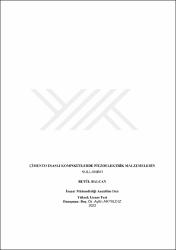| dc.contributor.advisor | Akyıldız, Aylin | |
| dc.contributor.author | Balcan, Betül | |
| dc.date.accessioned | 2023-04-27T20:41:09Z | |
| dc.date.available | 2023-04-27T20:41:09Z | |
| dc.date.issued | 2023 | |
| dc.identifier.uri | https://tez.yok.gov.tr/UlusalTezMerkezi/TezGoster?key=r4I1HnmXxFQovUpyAyUmxLqeqEiPJOFyKCXcpYw6noghxJiY1tKINh9LzqCn2wvx | |
| dc.identifier.uri | https://hdl.handle.net/20.500.11776/11630 | |
| dc.description.abstract | Piezoelektrik malzemelerin, birçok farklı alanda kullanımının artmasıyla beraber daha kapsamlı bir şekilde araştırılıp incelenmesine ihtiyaç duyulmuştur. Piezoelektrik malzemelere olan bu eğilim, dikkatleri inşaat mühendisliği alanına çevirmiştir. Piezoelektrik malzemelerin daha etkin kullanımını sağlamak için çimento esaslı piezoelektrik malzemelerin geliştirilmesi teşvik edilmektedir. Bu çalışma kapsamında üretilen harç numunelerine baryum titanat eklenerek harçların başta dayanım ve dayanıklılık özelliklerinin geliştirilmesi ve yapı malzemesi alanının gelişimine katkı sağlaması hedeflenmiştir. Ayrıca bu çalışmanın sonucunda yenilenebilir enerji konusunda önemli bir yere sahip olan piezoelektrik malzemelerin özelliklerinin iyileştirilmesi ve maliyetlerinin azaltılması ile gelecek nesilde başta yapı malzemeleri olmak üzere birçok alanın hızla gelişmesi ve enerji ihtiyacı sorunlarına bir çözüm önerisi olarak sunulacaktır. Yapılan çalışma hem inşaat sektöründe yeni bir malzemenin kullanılması, çevre ve teknoloji kullanımı açılarından son derece önemli bir konuda ürün geliştirilmesi hem de ürünün kullanımı konularında faydalı olacaktır. Çalışmada harçlara çimento ağırlığınca yüzde olarak 0.25, 0.5, 0.75 ve 1 oranlarında baryum titanat eklenerek numuneler üretilmiştir. Üretilen harç numunelerine ultrases geçiş hızı, eğilme dayanımı, basınç dayanımı, su emme, elektriksel direnç, elektromanyetik kalkanlama deneyleri ve SEM analizi yapılmıştır. Bu çalışmanın sonucunda eğilme dayanımı ve ultrases geçiş hızı değerlerinin % 0.25 katkılı BT2 numunesine kadar arttığı ve sonrasında azaldığı görülmüştür. Baryum titanat kullanım oranlarının artması ile elektriksel özdirenç değerlerinde artış olduğu ve dolayısıyla iletkenliğini düşürdüğü sonucuna varılmıştır. | en_US |
| dc.description.abstract | With the increasing use of piezoelectric materials in many different fields, there is a need for more comprehensive research and examination. This trend towards piezoelectric materials has turned the attention to the field of civil engineering. The development of cement-based piezoelectric materials is encouraged to enable more efficient use of piezoelectric materials. By adding barium titanate to the mortar samples produced within the scope of this study, it is aimed to improve the strength and durability properties of the mortars and to contribute to the development of the building material field. In addition, as a result of this study, it will be presented as a solution proposal to the rapid development of many fields, especially building materials, and energy need problems in the next generation, by improving the properties of piezoelectric materials, which have an important place in renewable energy, and reducing their costs. The study will be beneficial both in the use of a new material in the construction sector, in the development of a product that is extremely important in terms of environment and technology use, and in the use of the product. In the study, samples were produced by adding 0.25, 0.5, 0.75 and 1 percent barium titanate to the mortars by weight of cement. Ultrasound transmission velocity, bending strength, compressive strength, water absorption, electrical resistance, electromagnetic shielding tests and SEM analysis were performed on the produced mortar samples. As a result of this study, it was observed that the flexural strength and ultrasound transmission velocity values increased up to the 0.25% doped BT2 sample and then decreased. According to the results of the water absorption test, barium titanate increased the water absorption capacity. It was concluded that with the increase in barium titanate usage rates, the electrical resistivity values increased and thus the conductivity decreased. | en_US |
| dc.language.iso | tur | en_US |
| dc.publisher | Tekirdağ Namık Kemal Üniversitesi | en_US |
| dc.rights | info:eu-repo/semantics/openAccess | en_US |
| dc.subject | İnşaat Mühendisliği | en_US |
| dc.subject | Civil Engineering | en_US |
| dc.subject | Baryum titanat | en_US |
| dc.subject | Barium titanate | en_US |
| dc.subject | Harç | en_US |
| dc.subject | Mortar | en_US |
| dc.subject | Kompozitler | en_US |
| dc.subject | Composites | en_US |
| dc.subject | Piezoelektrik | en_US |
| dc.subject | Piezoelectric | en_US |
| dc.subject | Yapı malzemeleri | en_US |
| dc.subject | Building materials | en_US |
| dc.subject | Çimento | en_US |
| dc.subject | Cement | en_US |
| dc.title | Çimento esaslı kompozitlerde piezoelektrik malzemelerin kullanımı | en_US |
| dc.title.alternative | Use of piezoelectric materials in cement based composites | en_US |
| dc.type | masterThesis | en_US |
| dc.department | Enstitüler, Fen Bilimleri Enstitüsü, Yapı Malzemesi Ana Bilim Dalı | en_US |
| dc.identifier.startpage | 1 | en_US |
| dc.identifier.endpage | 64 | en_US |
| dc.institutionauthor | Balcan, Betül | |
| dc.relation.publicationcategory | Tez | en_US |
| dc.identifier.yoktezid | 785545 | en_US |



















